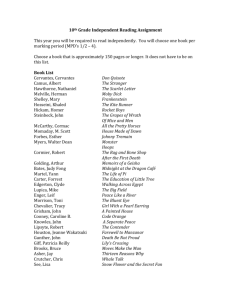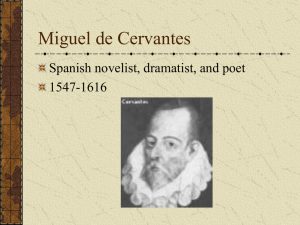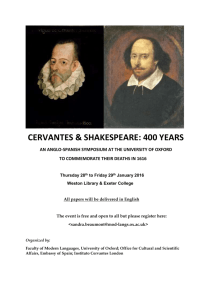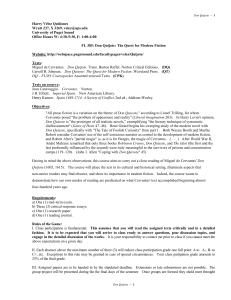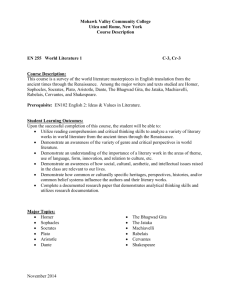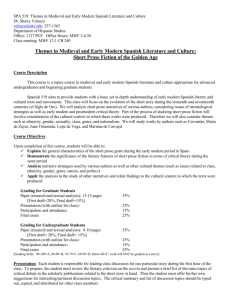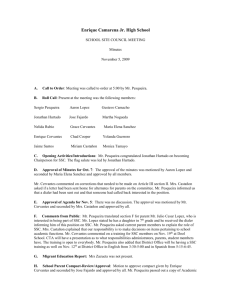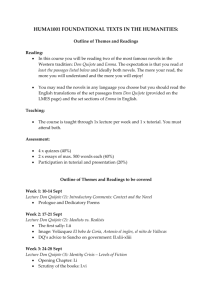Chivalry to the Rescue: The Dynamics Liberation in Don - H-Net
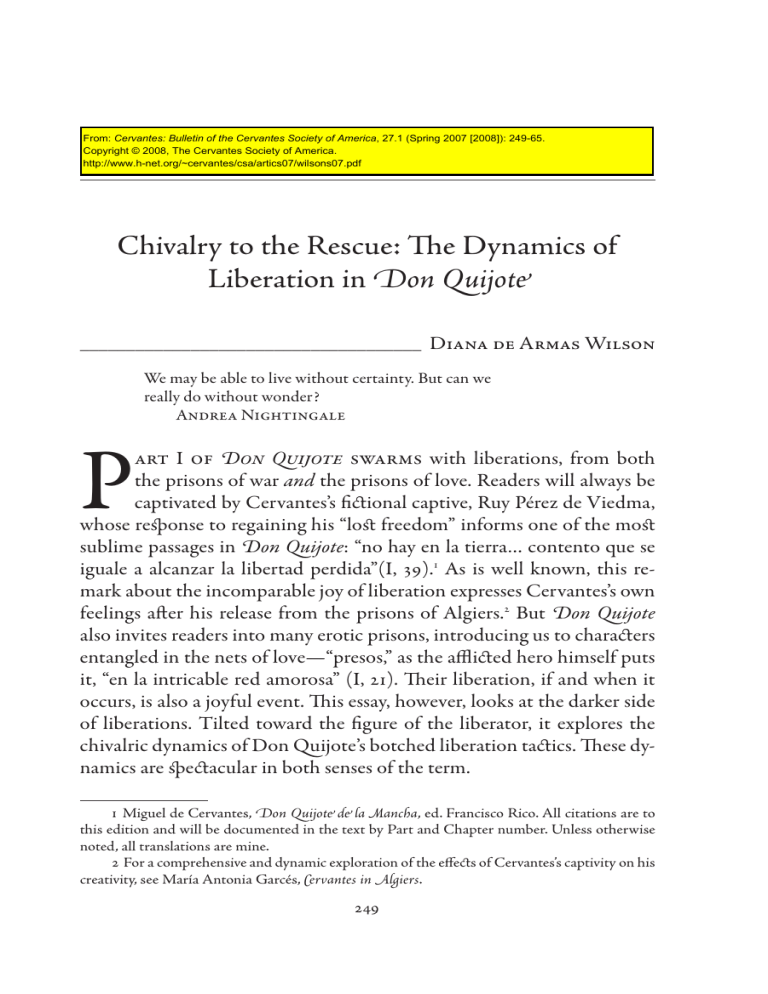
From: Cervantes: Bulletin of the Cervantes Society of America , 27.1 (Spring 2007 [2008]): 249-65.
Copyright © 2008, The Cervantes Society of America.
http://www.h-net.org/~cervantes/csa/artics07/wilsons07.pdf
Chivalry to the Rescue: The Dynamics of
Liberation in Don
Q
uijote
_____________________________________ Diana de Armas Wilson
We may be able to live without certainty. But can we really do without wonder?
Andrea Nightingale
P art I of Don Quijote swarms with liberations, from both the prisons of war and the prisons of love. Readers will always be captivated by Cervantes’s fictional captive, Ruy Pérez de Viedma, whose response to regaining his “lost freedom” informs one of the most sublime passages in Don Quijote : “no hay en la tierra… contento que se iguale a alcanzar la libertad perdida”(I, 39).
1 As is well known, this remark about the incomparable joy of liberation expresses Cervantes’s own feelings after his release from the prisons of Algiers.
2 But Don Quijote also invites readers into many erotic prisons, introducing us to characters entangled in the nets of love—“presos,” as the afflicted hero himself puts it, “en la intricable red amorosa” (I, 21). Their liberation, if and when it occurs, is also a joyful event. This essay, however, looks at the darker side of liberations. Tilted toward the figure of the liberator, it explores the chivalric dynamics of Don Quijote’s botched liberation tactics. These dynamics are spectacular in both senses of the term.
1 Miguel de Cervantes, Don Q uijote de la Mancha , ed. Francisco Rico. All citations are to this edition and will be documented in the text by Part and Chapter number. Unless otherwise noted, all translations are mine.
2 For a comprehensive and dynamic exploration of the effects of Cervantes’s captivity on his creativity, see María Antonia Garcés, Cervantes in Algiers .
249
250 Diana de Armas Wilson Cervantes
We all remember those roadside conflicts that end as failed liberation scenarios. Who can forget Don Quijote’s inept liberation of the abused farmboy Andrés (who curses him for it) (I, 3 and I, 31)? Or of the chaingang of galley slaves (who stone him for it) (I, 22)? Although the chief galley slave Ginés de Pasamonte smoothly greets Don Quijote as their
“lord and liberator” (“señor y libertador nuestro”), the liberation quickly collapses (I, 22). Both of these interventions trigger some savage violence, including a long hospitalization for Andrés, who later blames his liberator for it (I, 31). A similar dynamic occurs in the two female liberation scenarios that virtually frame Part I, in which Don Quijote comes to the rescue of two different “noble” ladies he thinks are being forcibly kidnapped: the Basque matron or “princess” in a coach (“alguna princesa en aquel coche)” early in Part I (I, 8), and the statue of the Virgin Mary at its close (“aquella buena señora que allí va cautiva”) (I, 52). The matron’s liberation costs Don Quijote half an ear (I, 9) and the Blessed Virgin’s, a shoulder smashed to pieces (I, 52).
But nowhere in Cervantes is the topic of liberation more spectacular
(in a classical sense of that word addressed later) than in Maese Pedro’s puppet show (“la graciosa aventura del titerero”) (II, 26), an episode that glosses all the failed liberation scenarios in Part I. Don Quixote and Sancho visit an inn or venta that is featuring, for the evening’s entertainment, a puppet show by a kind of itinerant mountebank. Although the show has no formal title, it is at various points called “la libertad de Melisendra.” Cervantes recycles an old Carolingian liberation narrative with human simulacra. As we “watch” these puppets ( títeres ) act out their script, we recognize how radically Cervantes altered the legend, and the dynamics, of liberation.
Apart from being set to music by Manuel de Falla in 1922 (“El Retablo de Maese Pedro”), Cervantes’s puppet show has been finely explored through various literary, historical, and performative readings.
3 My own approach to this episode is more political and, in an ancient and oblique fashion, philosophical. After a few prefatory remarks on Don Quijote’s imperial ambitions, I take some giant steps down the centuries, moving
3 Memorable critical readings include those of George Haley (145-65), Mary Malcolm
Gaylord (117-47), and Bruce R. Burningham (165-200).
27.1 (2007) The Dynamics of Liberation in Don Quijote 251 from the episode’s Virgilian overture, to its Carolingian rescue plot, to its Renaissance commentary on the wages of liberation. Finally, I close with some remarks about Cervantes’s spectacle as a wonder show, using the ancient quality of “wonder” as explicated by Andrea Nightingale in
Spectacles of Truth in Classical Greek Philosophy .
The Imperial Strain
Our fondness for Don Quijote should not allow us to overlook certain imperial ( and imperious) strains of his mania: his fantasy of becoming
“el mayor señor del mundo” (II, 39), his studied imitations of Saracenfighting knights, and his wild impulsivity in acts of liberation. In keeping with the global ambitions described by Anthony Pagden in his classic study Lords of All the World , Don Quijote’s imperial fantasies begin as early as Part I, 1. Among other bibliomanias, Cervantes’s newly-hatched madman pictures himself already wearing the crown “del imperio de
Trapisonda,” in imitation of a fictional knight who wore that same imperial crown, Reinaldos de Montalbán. This knight—whom Don Quijote professes to admire above all others—famously stole the (so-called) “ídolo de Mahoma” from Islamic territories (I, 1). The idea of Muslims with idols is, of course, as fanciful as that empire in Trapisonda. Less absurd, however, is Don Quijote’s strong identification with Carolingian figures in what was popularly called their “wars against the heathens.” Part of his initial fantasy is his readiness to sacrifice both niece and housekeeper in order to avenge the massacre of “los doce Pares” by beating up the traitor Ganelon (“al traidor de Galalón”) (I, 1). In Don Quijote’s famous assertion of self-knowledge soon after—“Yo sé quien soy…” (I, 5)—he aims to outdo the Twelve Peers, whose behavior, he later tells the Canon of Toledo, is “como una religión”
(I, 49). While in the sierra, Don Quijote considers imitating the valiente
Roldán” à la Orlando Furioso in his special fury over Angelica’s “vile” behavior with Medoro—her “más de dos siestas” with a Moor (I, 25). But when
Don Quijote attempts to help two Christian puppet-lovers escape from a cavalcade of miniature Moors in Maese Pedro’s puppet show, he joins the ranks of Charlemagne and Don Gaiferos, major players in the bardic versions of Europe’s struggle against Islam.
The whole pseudo-historical Carolingian legacy found its way into
252 Diana de Armas Wilson Cervantes
Don Quijote’s culture, into his library and, finally, into his brain. A heavy consumer of chivalric spin, Cervantes’s would-be knight aims to revive a mythical heroic past where Christians battle against pagans like the “furibundo” Alifanfarón, inspired by his “ falso profeta Mahoma” (I, 18). Don
Quijote’s revival of the past occurs in an age he regards as “detestable” (I,
38), an age of imperial losses, when global wars, bankruptcies, plagues, and famines are bringing down Spain’s empire. His mad enterprise, it has been argued, is fraught with denial.
4
Denial of a loss of empire, fixation on olden times, golden times, chivalric times: this is not an exclusively Spanish response. After Britain’s loss of empire last century, the English author C. S. Lewis argued for “The
Necessity of Chivalry”—the title of one of his essays. The word chivalry is as slippery as the term empire , to which it is related through a shared aristocratic ideology. Although Lewis notes that chivalry “has meant at different times a good many different things—from heavy cavalry to giving a woman a seat in a train”—the institution cannot be divorced from either the martial arts or a warrior aristocracy. C. S. Lewis saw chivalry as an ideal he wanted to revive in the 1950s. He believed chivalry would be
“terribly relevant” (13) to the post -World War II world and that it would be “especially necessary as we grow more democratic” (16). I suspect that
C. S. Lewis, an engaging writer with a relentlessly Anglo-Saxon imagination, never read Don Quijote . Lewis’s ideal warrior comes straight out of the chivalric romances, the literature that dried up Don Quijote’s brain.
“The knight is a man of blood and iron,” Lewis writes, “a man familiar with the sight of smashed faces and the ragged stumps of lopped-off limbs; he is also a demure, almost a maidenlike, guest in hall, a gentle, modest, unobtrusive man” (13). This seems a contradiction: a maidenlike man who is familiar with, and no doubt responsible for, “smashed faces” and “lopped off limbs.” But Don Quijote lives up to this exact chivalric ideal in Maese Pedro’s puppet show, where his intervention brings down the house—in all senses of that phrase. Let us look again at this wondrous display of blood and iron, fittingly introduced by an allusion to classical war stories.
4 See Christopher Britt Arredondo, Q uixotism: The Imaginative Denial of Spain’s Loss of
Empire .
27.1 (2007) The Dynamics of Liberation in Don Quijote 253
The Æneid as Precursor
The puppet show’s curtain-raiser is a one-liner from Virgil’s Æneid , specifically from a 1557 Spanish translation of a composite quote from that epic: “Callaron todos, tirios y troyanos.” 5 These words recall an audience of hushed Trojans and Carthaginians as they prepare to hear Aeneas recount the fall of Troy. We marvel at Cervantes’s generic effrontery, his comparison of a traveling puppet show with a canonized imperial epic.
But there is more here than a mere blurring of generic distinctions. As the prelude to a story about Charlemagne and his Frankish ventures, Virgil’s quotation points to a legend about the Trojan origins of the Franks. But the quotation also links the spectators in a Spanish roadside inn to the audience in Dido’s Carthage, a flashback of some sixteen centuries. T. S.
Eliot does something similar in The Wasteland when he links himself and a contemporary to a Roman war neither man fought in: “You who were with me in the ships at Mylae.” 6
But the past is prologue in Cervantes’s puppet show for yet another reason. The Romans provided a stunning model not only for the rise of empire—which Aeneas initiates when he sails from Carthage—but also for its fall. A leading Dante scholar teaching the Æneid at Stanford begins by telling her students that it is “the single most relevant poem” she knows, because “it is not only about the glory but also about the price of empire.” 7 Cervantes recognized the Roman imperial legacy behind
Spain’s expansion, a legacy currently being reassessed by classicists.
8 But he also recognized some of the legacies that Spain denied. Unlike the Romans, the Spanish tried to exclude alternative cultures from their midst
(see Kamen, 342). Much has been written on Judaism and Islam as mutilated branches of Spanish Golden Age culture. We know that the Islamic
5 “Tyrii, Troesque… Conticuere omnes intentique ora tenebant” ( Aeneid , Liber I, 747 &
Liber II, 1). Spanish translation by Gregorio Hernández de Velasco (Amberes, 1555).
6 T. S. Eliot’s The Wasteland refers in line 70 to the Battle of Mylae (260 bce), a conflict in the First Punic War between Rome and Carthage. Romans destroyed fifty Carthaginian ships and attained dominance in Sicilian waters.
7 Rachel Jacoff, conversation in February, 2005. I thank Professor Jacoff for reading an early draft of this essay.
8 For a study of classical models in early modern Spanish America, see David A. Lupher,
Romans in a New World . In Cervantes’s Numancia , the early Iberians heroically resist the siege of their city by a collective suicide.
254 Diana de Armas Wilson Cervantes branch was being mutilated even as Cervantes was writing Part II of Don
Quijote , which addresses the morisco tragedy in the Ricote episode (II,
54). Some of the roots of that tragedy may be found in the Carolingian legends that Maese Pedro’s puppets are recycling, as what follows will show.
The Carolingian Subtext
The puppeteer’s apprentice—the “muchacho” or “intérprete” or “trujamán” who narrates the show—assures us in his voice-over that it is a
“true story” (“Esta verdadera historia…”). This is, of course, a lie. The puppets are miming a legend “de las corónicas francesas y de los romances españoles” (I, 26), a legend that deals with Don Gaiferos’s liberation of his betrothed Melisendra from Moorish captivity in Sansueña (present-day
Zaragoza). Melisendra and Don Gaiferos are pseudo-carolingian cousins, both related to Charlemagne, the son of Pépin, a barbarian who built a powerful Frankish empire, and the grandson of Charles Mantel. Pope
Leo III crowned Charlemagne as Holy Roman Emperor of the West on
Christmas Day, 800 AD.
The emperor’s fake nephew Don Gaiferos was supposedly one of the
Twelve Peers and cousin to Roland (“su primo… don Roldán”), whose massacre at Roncevaux (Roncesvalles) on 15 August 778 ad, along with some twenty thousand other French warriors, is famously memorialized in the Chanson de Roland.
The fictional time of Cervantes’s puppet show, however, is before Roncevaux, since Roland is alive and well and curiously reluctant to lend Don Gaiferos his precious sword Durindana for
Melisendra’s rescue mission. Over the centuries, the French had reconstituted Charlemagne as the great champion of Christianity against Islam, and his Twelve Peers as tremendous Moor slayers. The true story of Charlemagne in Spain was much less heroic, as Cervantes suggests when he bends and even breaks the legend, leaving us with a puppet sliced in half:
Carlomagno “partido” (“de arriba abajo”).
According to Charlemagne’s own chronicler Einhard (770?-840?), a
Frankish noble who wrote the Vita Caroli Magni , the emperor had not fought any holy wars in Spain. He had merely gone there in 778 ad to help one Muslim leader fight another: specifically, the governor of Bar-
27.1 (2007) The Dynamics of Liberation in Don Quijote 255 celona, Sulaymān Yaqzan ibn al ‘Arabi, and other “Saracen princes” had requested assistance from the Franks in their rebellion against the emir of Córdoba. Charlemagne’s Spanish expedition was opportunistic, triggered by dissensions among the Saracens, as Christians then called the followers of Islam. 9 After a six-week siege of Zaragoza, Charlemagne retreated. En route back to France from this expedition, when his rearguard was separated from the main army as they were crossing the Pyrenees, some marauding Basque tribes—Christians not Muslims—ambushed and massacred the Franks, including Roland (Hruodlandus), Count of the Marches of Britanny. The French transformed the history of Charlemagne’s Spanish exploits, turning an abortive expedition into a holy war, and the Basques into Saracens—an enemy whom they could attack with impunity.
10 “Thou shalt have vengeance upon the heathen horde,” an angel in the Chanson de Roland tells Charlemagne, who declares, at the epic’s end, “Never to Paynims may I show love or peace.” 11
When Pope Urban II summoned the First Crusade in 1095, calling for “wars of liberation” to reclaim the Holy Land from “a race absolutely alien to God,” he looked back to Charlemagne for inspiration (Acocella,
92). Scholars are currently divided on the Crusades: whereas older historians consider them “a vast fiasco” that planted anti-Semitic and anti-
Muslim sentiment in the Western identity, some recent British historians are entertaining the so-called “Christian theory of positive violence” as
“the motor of the Crusades.” Scholars in this last camp claim see violence as normative in medieval life: “Seizing your brother-in-law’s castle, cutting off his nose—these were unremarkable activities” (Acocella, 94).
12
However one may wish to interpret the motivation for the Crusades, what cannot be denied is their roots in the Carolingian traditions of a
9 See Karen Armstrong, Holy War, 64. On “Saracen” as a pre-Islamic and pre-Christian term of ethnic rather than religious connotation and “of uncertain etymology,” see Bernard Lewis,
133.
10 See Alessandro Barbero, Charlemagne , 57; also Armstrong, Holy War , p. 64.
11 Song of Roland , stanza 179 (145) and stanza 260 (188).
12 Steven Runciman considered the Crusades an enormous fiasco in his History of the
Crusades , an opinion more recently shared by Karen Armstrong ( Holy War , pp. 66, 61, 65).
On “positive violence,” see Thomas Asbridge, The First Crusade: A New History and Jonathan
Phillips, The Fourth Crusade and the Sack of Constantinople .
256 Diana de Armas Wilson Cervantes knightly aristocracy founded on warfare against so-called “Saracens” or
“heathens” or “paynims.” After centuries of legendary accretion, these traditions were responsible for a number of submerged crusading myths still potent in Cervantes’s day. Charlemagne and Roland are consistently ridiculed in an early and little-known play by Cervantes, Casa de los celos y selva de Ardenia . Let us consider his treatment of these figures three decades later.
Liberating Melisendra
In Maese Pedro’s puppet show, Carlo Magno is introduced as Melisendra’s “padre putativo,” perhaps a dig at an emperor who had five wives and six concubines and produced twenty children, a number of them “by unknown mothers.” 13 Unready, it would seem, to liberate his own daughter, he projects his anger on Melisendra’s playboy husband. Don Gaiferos is presented as a reluctant liberator—spending some seven years in
Paris with little thought of his captive lady. His reluctance was already present in the Spanish ballads, but Cervantes comically theatricalizes it. He has the puppet Carlo Magno approach his son-in-law while he is playing backgammon (“jugando a las tablas”), berate him for his laziness in liberating his wife, and consider giving him half-dozen scepter-blows
(“coscorrones”) to prod him out of Paris. Don Gaiferos responds with a fit of rage (“impaciente de la cólera”), tossing the board game and its pieces across the puppet stage. The legendary Gaiferos did finally manage to rescue Melisendra from the Muslim King Marsilio of Sansueña.
In Cervantes’s puppet show, however, the plot of this chivalric rescue is tripled and mangled. Chivalry comes to the rescue three times in the course of the spectacle, and in three different ways: legally, belatedly, and destructively. All these rescue jobs, two on stage and one offstage, trivialize both the Carolingian heroics and their crusading pieties.
Melisendra is first of all rescued from a nasty sexual predator. In our initial view of her in Sansueña, when the boy-apprentice points to her with his wand, she appears on a balcony, in Moorish dress, as a damsel both in captivity and in distress. Stalked by a slobbering Moor who kisses
13 See Chapter 6, “The Man and His Family,” in Barbero , 116-140.
27.1 (2007) The Dynamics of Liberation in Don Quijote 257 her ardently, she spits in disgust, wipes her mouth, and tears at her hair.
But she is quickly rescued by another Moor—by King Marsilio himself— who instantly punishes the insolent kisser, even though he is a relative and political crony . Having given us this little window into Islamic justice, the boy-narrator launches into a legalistic tirade about the unseemly dispatch of Muslim sentencing procedures. Don Quijote interrupts to demand that he follow his story in “línea recta,” and Maese Pedro agrees that he should avoid “contrapuntos.” The issue of cultural differences interrupts the show various times, as, for example, when the boy ignorantly installs church bells in the towers of the mezquitas and Don Quijote corrects him (“¡Eso no!—porque entre moros no se usan campanas”). This interruption, one of several comic ruptures in the puppet show, brings up cultural differences even as it distracts us from a surprising truth: that
Islamic justice actually works on Melisendra’s behalf here. This may be the best of her rescue jobs.
In the second rescue, which also takes place on stage, Melisendra is boorishly liberated by her husband—whom the boy-narrator has now upgraded to a “valeroso enojado.” Don Gaiferos finally arrives in Spain incognito but frenchified by a hooded Gascony cape. When Melisendra recognizes her liberator, she ecstatically pitches herself off the balcony.
Caught in mid-air by her petticoat on the balcony railings, she is unceremoniously yanked onto the horse by Don Gaiferos. The pair then begins galloping off to Paris.
Chivalry comes to Melisendra’s rescue, for the third and last time, from off-stage and in the person of Don Quijote. The conflict on stage between “moros y cristianos” has become uglier—with a Moorish cavalry of puppets (“la titerera morisma”) galloping after the two “católicos amantes.” Just as the drama cuts to the chase, the boy-narrator worries aloud that the couple might be caught by the Moors and tied to their horse’s tail—an outcome he foresees as “un horrendo espectáculo.” One could argue that he exaggerates the Muslim threat, since any spectator versed in the ballad tradition would know that the lovers returned to
Paris in triumph, that their escape was guaranteed by legend. But at this point, Cervantes explodes the legend.
Caught by the pseudo-reality of that “spectacle” of Moorish cruelty,
258 Diana de Armas Wilson Cervantes
Don Quijote decides to lend a hand to Don Gaiferos, who has now morphed even further, from a bad husband to an angry warrior to an“atrevido enamorado.” The rest is madness: Don Quixote unsheathes his sword, leaps into the fray, and furiously rains down blows on the crowd of puppets, knocking down some, beheading others, bruising some, destroying all. Maese Pedro screams out that the figures he’s destroying are not real
Moors—“[no son] verdaderos moros”—but only “figurillas de pasta.”
In his fury, however, Don Quijote destroys far more than fake Moors.
He slices through Carlomagno’s crowned head: Charlemagne, split in twain, no longer rules. But Don Quijote also defaces the very figure he set out to rescue, Melisendra, leaving her “sin narices.” With this violent move, he ironically repeats the practice of the corsair Arnaut Mamí— famous for cutting the noses off his Christian galley slaves, as María Antonia Garcés notes (155). Melisendra is not liberated but mutilated.
The first time I read this episode, I laughed aloud at Cervantes’s description of “Melisendra desnarigada.” It is easy to laugh at a disfigured puppet, at a pasteboard doll left “sin narices y con un ojo menos” (II, 26).
It is hard not to laugh at the sublime silliness of Don Quijote’s violent attack on a population of puppets. My response to this episode has altered, however, in the aftermath of our nation’s “liberation” of Iraq. While we can scarcely expect the dynamic of liberation to produce prolonged gratitude among the liberated, our enterprise has produced a host of questions anticipated by Cervantes and prefigured in Don Quijote . At what point is it madness to attempt a liberation? Why are some liberations so inept?
Who are the so-called “intelligence agents”? Who are the criminals in hiding? Who is manning the checkpoints? Who gets caught in the crossfire? What are the costs of liberation, to bodies as well as nations? And, finally, why are post-liberation rulers so often likened to puppets? Don
Quijote’s rescue tactics once served, and may still serve, as a kind of reality check for would-be liberators.
The Costs of Carnage
To add insult to injury, Don Quijote must finance all the damages of the liberation. In keeping with the Pottery Barn rule—“ You break it, you own
27.1 (2007) The Dynamics of Liberation in Don Quijote 259 it ” 14 —he must pay for the heavy cardboard “carnage,” the beheadings and dismemberments of all the puppets, both Muslim and Christian. After
Maese Pedro launches into a legendary lamentation (“Ayer era rey de
España…,” etc.), a penitent Don Quijote blames his “enchanters” for all those lopped-off limbs: they have been persecuting him, changing people’s identities, giving him “bad intelligence.” When he balks at compensation for the figure of Melisendra—who must surely be enjoying herself back in France with her husband (“con su esposo a pierna tendida”)—Maese
Pedro quickly placates him (“Esta no debe de ser Melisendra”).
The comic exchanges about the value of each puppet underline what
Carroll Johnson has finely disclosed as “the pervasive presence” of material practices in Don Quijote ,” where “feudo-chivalric” approaches clash with “incipient capitalism” (10).
The scene is also deeply ironic in that Don Quijote actually sentences himself to pay the costs (“quiero yo mismo condenarme en costas”), a move that fits under the rubric of tort liability. Beyond a breach of contract, a tort is defined as a civil wrong that may be remedied by law in the form of monetary damages. Don Quijote’s original decision to become a knight errant, as we recall, was motivated by a world of grievances to be redressed, abuses to be rectified, and “tuertos” to be remedied. He remedies this particular tuerto by compensating his victim, the puppeteer Maese
Pedro who, we soon discover, is none other than Ginés de Pasamonte: a fugitive hiding behind an eyepatch from the Santa Hermandad, a criminal on the run whom Don Quixote once liberated, a prisoner who cast the first stone at his liberator. We are left with a chastened hero who pays for the wreck of the puppets—a total of 42¾ reales — and for the communal supper that follows it—for which Cide Hamete calls him “liberal en todo estremo.”
The Moorish Author
But there is still more puppetry afoot here. Behind the voice-over of the boy-apprentice, there is a clutch of other voices. Cervantes has been ventriloquizing a Christian liberation story in an Islamic voice. We have all
14 The original source of this “Pottery Barn rule” may be Colin Powell and Richard
Armitage or Tom Friedman. Cited by William Safire, “On Language.”
260 Diana de Armas Wilson Cervantes heard the cliché that history is written by the winners. But if Don Quixote is any model, the novel is best written by the losers —in this case by a member of a suspect and soon-to-be expelled minority. In a sly imitation of a technique first found in Amadís , Cervantes attributes his work to a fictitious “author”—an Arab historian who has handed down the archived exploits of a would-be Christian knight. This makes Cide Hamete
Benengeli into Cervantes’s master puppet.
A duplicitous figure, an ambivalent figure, a hybrid figure, Cervantes’s pseudo-author swears “como cristiano católico” in one chapter (II, 27) and blesses “the mighty Allah” in the next (II, 28).
15 All this confusion is,
I think, a strategic erasure of ethnic difference, the kind of ploy found in a brilliant line from Shakespeare’s most problematic play: “Which is the merchant here, and which the Jew?” ( Merchant of Venice , IV.1). To a world now rethinking Christian-Muslim tensions, Cervantes’s choice of a Moorish filter seems more than a comic device. I see it as an aid to reflection and, in turn, to dialogue. One must hope for a Muslim-Christian
“dialogue of civilizations,” a phrase used by the Pakistani Islamic scholar
Akbar Ahmed to forestall the dreaded “clash of civilizations.” 16 The dialogic imagination is basic to philosophy and, as Bakhtin long ago showed us, to the Cervantine novel. Both enterprises meet in Cide Hamete, who near the end of Part II is praised as a “ filósofo mahomético” (II, 53; emphasis mine).
But there is a second Moorish puppet in the wings here. As best supporting actor we have the nameless morisco aljamiado, the figure who translates Cide Hamete’s text into Spanish. The fictional Cervantes drags the translator out of the Toledo marketplace (the Alcaná) and into a church cloister, where he hires him for a fee of “dos arrobas de pasas y dos fanegas de trigo” and takes him home for six weeks. Cervantes’s own ancestors may have been a persecuted minority— conversos who spoke the
“ mejor y más antigua lengua” of Hebrew (I, 9)—an issue enlightened by
Francisco Márquez Villanueva in his lecture “La cuestión del judaísmo
15 John Jay Allen provides an elegant reading of Cide Hamete in “Levels of Fiction,” 921.
16 Akbar Ahmed uses Ibn Khaldun, a 14 such a dialogue (20-45). th -century “social scientist,” in order to enlighten
27.1 (2007) The Dynamics of Liberation in Don Quijote 261 de Cervantes.” 17 If the question of his converso origins is true, then the fictional Cervantes’s hospitality to a Morisco translator might rattle our inter-ethnic expectations. The translator featured here may have been modeled on one of those “3500 Moriscos from Granada (between 10 and 60 years of age)” who, Fernand Braudel notes, were “transported from the capital to the neighbouring province of La Mancha” (II, 791) in 1569.
18 He may have been a forced Muslim convert to Christianity— which does not bode well for the translation. In 1611, Covarrubias defines moriscos with an if-clause: “Los convertidos de moros a la Fe católica, y si ellos son católicos, gran merced les ha hecho Dios y a nosotros también”
(763, emphasis mine).
To read Don Quixote in the original, then, is to read a fictional translation from the Arabic, the language of Spain’s official enemy. The representation of Muslims in Western literature has a grisly history. Readers will always decide for themselves the degree of Islamophobia in Don
Quijote . Anthony Burgess, author of that famously oppressive tale of torture Clockwork Orange , writes that Arabic was “the speech of torture and oppression” for Cervantes. In the Maese Pedro episode, however, Arabic turns out to be the speech of revelation, for it is Cide Hamete who ultimately reveals to us the “true identity” of the puppeteer.
This is puppetry of a dazzling order, with Cervantes manipulating a whole puppet regime—Cide Hamete, the morisco translator, Maese
Pedro, and his apprentice—to produce a spectacle that still speaks to us today. In 1605 Spain was intensifying a crusade to liberate itself from the so-called “infidel,” the moriscos whose official expulsion would begin in a few years. In 2005, we are struggling to replace this old “clash of civilizations” with a new “dialogue of civilizations.” The figure of Don Quijote may help us rethink our “duty” to free people—whether infidels in need of salvation or Muslims in need of democracy. In light of recent debates about coming to the rescue of civilizations that must be leveled in the process, Cervantes’s centuries-old puppet show should nail us to our seats today.
17 “La cuestión del judaísmo de Cervantes,” presented at “One More Crossroads: Don
Q uijote at Four Hundred , was not made available for publication in this issue.
18 Braudel adds that “all historians are of course on the side of the Moriscos” (II, 795).
262 Diana de Armas Wilson Cervantes
Theorizing the Wonder Show
But there are other, more philosophical, reasons to rethink this show.
Maese Pedro’s retablo is a kind of wonder show in the most ancient and classical sense. The text describes it as a “retablo… de… maravillas” when it notes that the spectators were riveted to the mouth of its interpreter, who declaimed its wonders (“pendientes… de la boca del declarador de sus maravillas”) (II, 26). Our sense of wonder is engaged by the first description of the retablo , surrounded by countless small lit candles that make it showy and resplendent (“lleno por todas partes de candelillas de cera encendidas, que le hacían vistoso y resplandeciente”) (II, 25). This marvelous retablo calls to mind Cervantes’s politically-conscious entremés
“El retablo de las maravillas.” Translated by Edwin Honig as “The Wonder Show” (109-23). Cervantes’s interlude turns on a fake tableau that only legitimate and pureblood Christians are privileged to see. There is an ancient link between spectacles, wonder, and philosophy, and I would like to suggest, in closing, that Cervantes’s puppet show reconnects these three entities.
In Spectacles of Truth in Classical Greek Philosophy , Andrea Nightingale meticulously investigates, through many Greek sources, the invention of philosophy or, more precisely, “the foundational construction of theoretical philosophy in its intellectual and its cultural context” (7).
This study takes up the ancient theories of theory to show how, in the traditional practice of theoria , an individual journeyed away from home for the purpose of witnessing certain spectacles: “The Greek word theoria means, in its most literal sense, witnessing a spectacle ” (4, n. 3). Nightingale’s argument, grossly simplified here, is that wandering across frontiers in the fifth century BCE translated into witnessing and wondering , the foundations of philosophy. Although Nightingale’s focus is on Platonic wonder, which has a metaphysical orientation, there are elements of this open-ended concept that invite comparison with Don Quijote’s own trip to “enlightenment.” 19
19 According to Nightingale, the Platonic conception of wonder occurs at the end of the philosophic quest and neither ceases nor abates with certainty. Whereas Aristotle moves from wonder to certainty, Plato leaves us a less dogmatic concept of wonder. See “The Fable of
27.1 (2007) The Dynamics of Liberation in Don Quijote 263
Cervantes’s knight journeys away from home and witnesses two spectacles that are intimately connected with the shattered world of Carolingian chivalry—spectacles that disclose the hollowness of his identification with these knights. The first spectacle occurs during a kind of reverse Platonic trip, a catabasis to an underground cave dwelling, a site allegorized as the human condition in Book Seven of Plato’s Republic .
Don Quijote’s dream or hallucination in the Cave of Montesinos identifies him with Durandarte, a literally heartless figure personified out of a heaven-sent sword Durindana (Durendal). In the Chanson de Roland ,
God sends an angel with the sword to Charlemagne, who then bestows it on Roland, who kills whole armies of Saracens with it. The sword is so powerful because, as Roland explains in an apostrophe to Durendal, it contains “a store of relics” in its golden hilt: a tooth of St. Peter, a hair of
St. Denis, some blood from St. Basil, and a swatch of the Virgin Mary’s robe.
20 The conversion of Roland’s sword Durendal into the mummified figure of Durandarte in the Cave of Montesinos is a fall from the miraculous and heroic into the grotesque and necrotic.
21
In the subsequent spectacle of Maese Pedro’s retablo , Don Quijote sees and destroys a crowd of Carolingian puppets. The spectacle he has witnessed onstage, along with the boy-narrator’s anxiety about a “horrific spectacle” of Muslim reprisals, causes Don Quijote to make a spectacle of himself. We as readers are invited to “theorize,” in the ancient sense of witnessing, these nested spectacles of chivalry-to-the-rescue. We are also moved to theorize, in the later and more philosophical sense, a rescue mission that liberates an old legend from centuries of crusading spin.
Through Cervantes’s wonderful puppetry, we have witnessed a “spectacle of truth” about Holy Wars—wherever and whenever they take place.
Philosophy in Plato’s Republic” (94-138) and “Epilogue” (253-68).
20 Song of Roland , stanza 172-173. Roland’s sword, “Durendal” or “Durandarte” in Ariosto’s
Orlando Furioso , is called “Durindana” in the puppet show. In a ballad from the Carolingian cycle, known to the age of Cervantes, Durandarte begs his cousin Montesinos to carve out his heart after his death and carry it to his lady Belerma. Cervantes preserves the mummified heart with salt.
21 The cueva episode could be read as a parody of Plato’s Allegory of the Cave, which
Nightingale calls “the foundational story of enlightenment” in Western culture. Conversation with Nightingale, March, 2005.
264 Diana de Armas Wilson Cervantes
University of Denver
3788 North 26th St.
Boulder, CO 80304
Email: diwilson@du.edu
Works Cited
Acocella, Joan. “Holy Smoke.” The New Yorker (December 13, 2004): 92-100.
Ahmed, Akbar. “Ibn Khaldun’s Understanding of Civilizations and the Dilemmas of
Islam and the West Today.” The Middle East Journal 56 (2002): 20-45.
Allen, John Jay. “Levels of Fiction in Don Quixote ,” Don Quixote . Trans. John Ormsby. Ed. Joseph R. Jones and Kenneth Douglas (New York: W. W. Norton, 1981).
919-27.
Armstrong, Karen. Holy War: The Crusades and Their Impact on Today’s World. London: Doubleday, 1991.
Arredondo, Christopher Britt. Quixotism: The Imaginative Denial of Spain’s Loss of Empire .
Albany: SUNY Press, 2004.
Asbridge, Thomas. The First Crusade: A New History . Oxford: Oxford University
Press, 2004.
Barbero, Alessandro. Charlemagne, Father of a Continent . Trans. Allan Cameron. Berkeley, University of California Press, 2004.
Braudel, Fernand. The Mediterranean and the Mediterranean World in the Age of
Philip II . Trans. Siân Reynolds. 2 vols. New York: Harper & Row, 1973.
Burningham, Bruce R. “Dialogue and Maese Pedro’s Puppet Show.” Cervantes 23 (2003):
165-200.
Burgess, Anthony. “A Meeting in Valladolid,” The Devil’s Mode: Stories . New York:
Random House, 1989. 3-21.
Cervantes, Miguel de. Don Quijote de la Mancha . Ed. Francisco Rico and Joaquín
Forradellas. 2 vols. Barcelona: Instituto Cervantes, Editorial Crítica, 1998.
———. Interludes: Cervantes . Trans. Edwin Honig. New York: Signet, 1964.
Covarrubias Orozco, Sebastián de. Tesoro de la lengua castellana o española . Ed. Felipe
C. R. Maldonado. Madrid: Editorial Castalia, 1994.
Garcés, María Antonia. Cervantes in Algiers: A Captive’s Tale (Nashville: Vanderbilt
University Press, 2003.
Gaylord, Mary Malcolm. “Pulling Strings with Master Peter’s Puppets: Fiction and History in Don Quixote.” Cervantes 18 (1998): 117-47.
Haley, George. “The Narrator in Don Quixote : Maese Pedro’s Puppet Show.” MLN
80 (1965): 145-65.
Kamen, Henry. Empire: How Spain Became a World Power, 1492-1763 . New York:
HarperCollins, 2003.
27.1 (2007) The Dynamics of Liberation in Don Quijote 265
Lewis, Bernard. Islam and the West . Oxford: Oxford University Press, 1993.
Lewis, C. S. “The Necessity of Chivalry.” Present Concerns . New York: Harcourt Brace
Jovanovich, 1986. 13-26.
Lupher, David A. Romans in a New World: Classical Models in Sixteenth-Century
Spanish America. Ann Arbor: University of Michigan Press, 2003.
Márquez Villanueva,, Francisco. “La cuestión del judaísmo de Cervantes.” Lecture presented at “One More Crossroads: Don Quijote at Four Hundred,” international symposium held at Boston University, April 14-16, 2005.
Nightingale, Andrea. Spectacles of Truth in Classical Greek Philosophy.
Cambridge:
Cambridge University Press, 2004.
Pagden, Anthony. Lords of all the World: Ideologies of Empire in Spain, Britain and
France c. 1500-c. 1800. New Haven: Yale University Press, 1995.
Phillips, Jonathan. The Fourth Crusade and the Sack of Constantinople . New York: Viking, 2004.
Runciman, Steven. History of the Crusades . 3 vols. Cambridge: Cambridge University
Press, 1951-54.
Safire, William. “On Language,” New York Times Magazine (17 October 2004).
Song of Roland . Trans. Dorothy L. Sayers. New York: Penguin Books, 1957.
